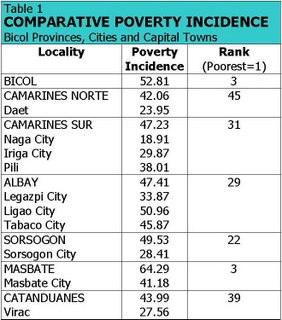Poverty, governance and Bicol LGUs, Part 1
NOTE: This is the first installment of a six-part series analyzing results of the data on local poverty released recently by the NSCB and their relevance to local governments in Bicol region.
A LITTLE known, newly circulated study by the National Statistics Coordination Board (NSCB) for the first time allows ordinary residents to see the comparative poverty picture at the provincial, city and municipal levels in the country, including the Bicol region.
Innocuously entitled “Estimation of Local Poverty in the Philippines,” the study answers the need for aggregated poverty information down to the municipal level. It can be downloaded from the NCSB website. Together with available reports on local government finances which can be accessed from the Commission on Audit (COA) website, the study can now allow students, academics and individual citizens to link poverty with governance issues.
The NCSB study, completed in cooperation with funding assistance from the World Bank, uses data from the 2000 population and housing census (CPH), labor force (LFS) and family income and expenditures (FIES) surveys to estimate three poverty measures – incidence, gap and severity – at the provincial and municipal levels.
Comparative poverty incidence
Table 1 below presents the comparative poverty incidence – defined as the proportion of households with average per capita income below poverty line – among the provinces, cities and capital towns in Bicol.
Immediately, the table shows why Bicol is the 3rd poorest region, better only than SOCCSKSARGEN and ARMM. Of the six provinces, only Camarines Norte ranks out of the top 40 poorest provinces. At 39th, Catanduanes has the best chance of getting out. But the rest are not doing as well, led by Masbate which has the dubious distinction of being in the top 10.
Among cities and capital towns, Naga recorded the lowest poverty incidence at 18.91%, affirming the effectiveness of its pro-poor programs. The next best performers are Daet, Camarines Norte; Virac, Catanduanes; and the cities of Sorsogon and Iriga.



0 comments:
Post a Comment